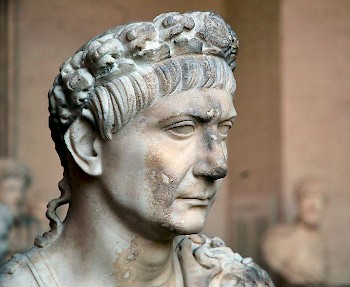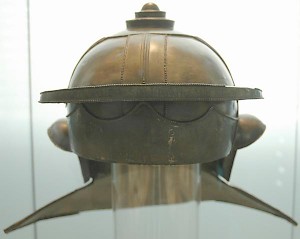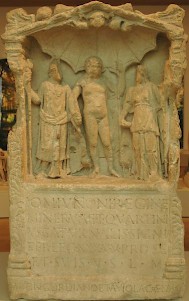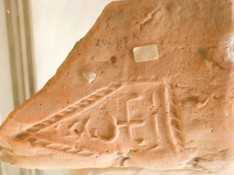Legio XXX Ulpia Victrix
Legio XXX Ulpia Victrix: one of the Roman legions. Its name means "the victorious legion of Ulpius".

The Thirtieth Ulpian legion and II Traiana Fortis were founded in 105 by the emperor Trajan,note who was fighting a war in Dacia (modern Romania). It was named after the emperor, who was a member of the Ulpius family. The number was chosen because the number of legions was now thirty.
The legion was first stationed in Brigetio (Szöny) in Pannonia Superior, which had shortly before been evacuated by XI Claudia. At least some subunits took part in the war against the Dacians. Because they behaved valiantly, the Thirtieth Ulpian legion received the surname Victrix, "winner".
Perhaps the legion also took part in Trajan's campaign against the Parthian empire, which started in 115 and ended in 117 in the largest disaster that befell the empire in almost half a century. However, there is not much evidence for its presence in the east. It is more likely that only a subunit was added to XV Apollinaris, which certainly fought in Mesopotamia. The rest of the legion may have been active in construction work along the Danube. Many inscriptions are witness to this activity.

In the years after 118, the legion was commanded by Quintus Marcius Turbo Fronto, a personal friend of the emperor Hadrian who was given large responsibilities to pacify Dacia, which had become restless after the death of Trajan. XXX Ulpia Victrix must have done some police work.
After 122, the legion was sent to Xanten - or, to use its Latin name, Castra Vetera - in Germania Inferior, which had been the camp of VI Victrix until it was transferred to Britain. Xanten was situated at the confluence of the Rhine and the Lippe, a river that was often used by the Romans to invade "free" Germania. The Thirtieth legion was to stay at Xanten for centuries; it was still there in c.400 and the civil settlement near the military base was for some time simply called Tricensimae, a dialect expression meaning "the thirtieth".
Germania Inferior is hardly mentioned at all in our sources, and inscriptions are our only evidence for the legion's activities. Military matters are almost absent, which suggests (perhaps falsely) that the region was quiet. An inscription mentions that a centurion rebuilt the sanctuary of Jupiter Dolichenus at Cologne; the same man erected two shrines for Mercury and the Matres Paternae ("fatherly mothers"). Other inscriptions prove that the governor of Germania Inferior used soldiers of the Thirtieth as clerks. A subunit of 50 soldiers operated six kilns at Iversheim.

One subunit was stationed with I Minervia (the other legion in this province) at Bonn. Other subunits of the Thirtieth seem to have stayed at Remagen and the border with Germania Superior. This is remarkable because both places are nearer to Bonn than to Xanten. The two legions often operated together. Inscriptions from the Dutch river area prove that they sometimes worked jointly at building projects, and many inscriptions simply mention "the army of Germania Inferior" (exercitus Germaniae Inferioris, frequently abbreviated as EXGERINF).
During the reign of Lucius Septimius Severus (198-211), subunits of these two legions and the two legions of Germania Superior (VIII Augusta and XXII Primigenia) served as garrison of Lyon, the capital of the Gallic provinces. The number of inscriptions of XXX Ulpia Victrix is remarkably high, and they continue until the reign of Severus Alexander (222-235). Other inscriptions suggest that soldiers of the Thirtieth were wanted all over Gaul: they are found in Châlons, Paris, Bourges, Auch (near the Pyrenees) and near the Col du Grand Saint Bernard.
It looks as if XXX Ulpia Victrix was some sort of temporary employment agency, but it did see military action as well. During the reign of Antoninus Pius (138-161), a subunit was stationed in Mauretania, where it had to fight against the Mauri. When I Minervia took part in the campaign against the Parthian empire of Lucius Verus (162-166), soldiers of the Thirtieth were present as well. It is likely that other units were involved in Marcus Aurelius' wars against the Marcomanni (165-175 and 178-180), and the campaign of the governor of Gallia Belgica, Didius Julianus, against theChauci in 173.
In 193, civil war broke out. Coins prove that the Thirtieth Ulpian legion immediately sided with Lucius Septimius Severus. This was courageous because another pretender, Clodius Albinus, was closer at hand. In 196/197, the legion must have been involved in the actual fighting. Severus was victorious and rewarded the legion of Xanten with the title Pia Fidelis ("faithful and loyal").

After 208, it probably took part in his Scottish campaign, and in 235 subunits were active during the Persian campaign of Severus Alexander. We now from archaeological finds that c.240 the frontier of the Lower Rhine collapsed, and we must assume that XXX Ulpia Victrix suffered a defeat, but it was also able to reconquer the Dutch river area. This was repeated in 256-258, when the Franks invaded Gaul. The emperor Gallienus was able to throw them back, and must have used the EXGERINF.
In 260, the Franks were back, and this time they were defeated by general Postumus, who was immediately proclaimed emperor and founded the Gallic Empire. XXX Ulpia Victrix sided with the usurper, who was able to offer peace to the region peace. However, after 274, the Roman emperor Aurelian reconquered Gaul, and took away much troops. Immediately, the Franks crossed the Rhine again, and the Dutch river area and Flanders were lost. For almost a quarter of a century, Xanten was the northernmost Roman garrison.

When order was restored by general Constantius I Chlorus, everything had changed. New, mobile cavalry armies in the hinterland had become the backbone of the Roman army. Legions along the river Rhine had become less important. They were stationed in strong castles, where they were supposed to notice the enemy, and wait until the cavalry arrived. XXX Ulpia Victrix remained at Xanten, probably on the site of the former civil settlement, but had lost its real significance. It disappears from history when the Rhine frontier collapsed in 407.
The symbols of XXX Ulpia Victrix were the gods Neptune and Jupiter and the Capricorn. It is a bit strange that during the reign of the emperor Gallienus (253-268), only Neptune was used, then, under the "Gallic" emperor Victorinus (269-271), the Capricorn, and under the British usurper Carausius only Neptune.
Literature
- Y. Le Bohec, "Legio XXX Vlpia", in: Yann Le Bohec, Les légions de Rome sous le Haut-Empire (2000 Lyon) 71-74
- article by Emil Ritterling.











